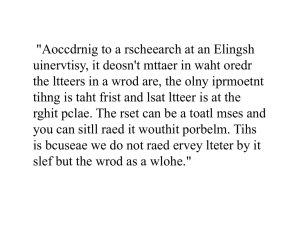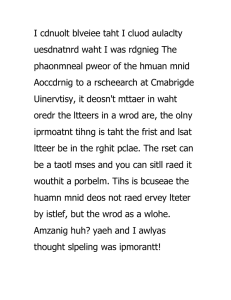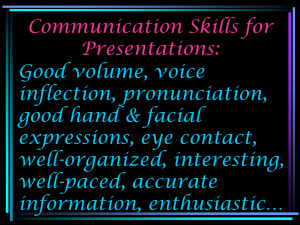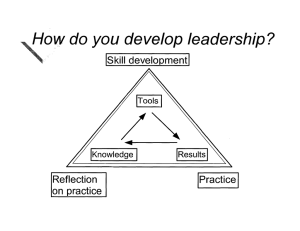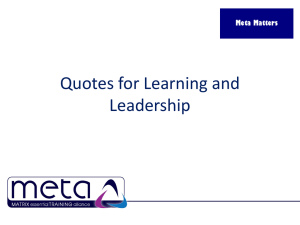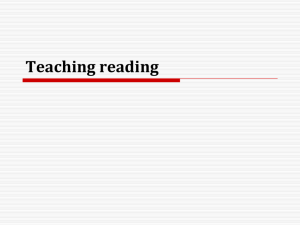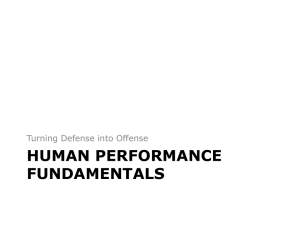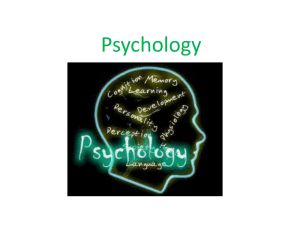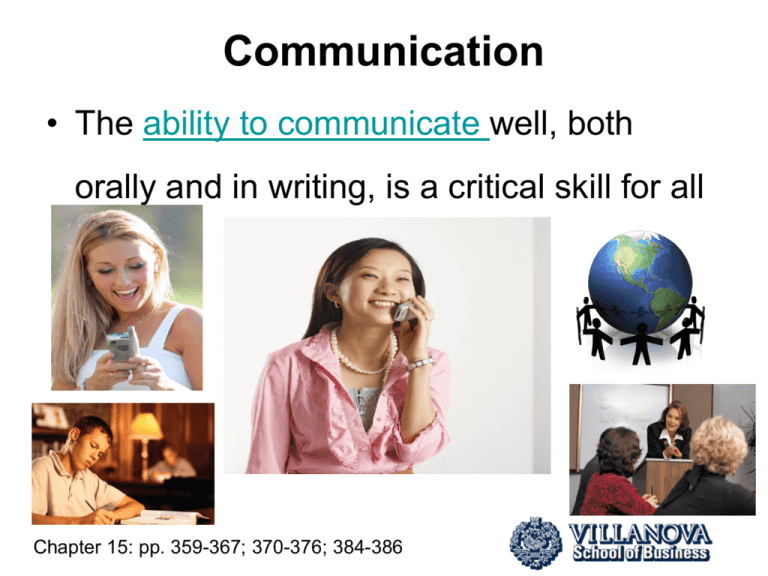
Communication
• The ability to communicate well, both
orally and in writing, is a critical skill for all
Chapter 15: pp. 359-367; 370-376; 384-386
Aoccdrnig to rscheearch at Cmabrigde
Uinervtisy, it deosn't mttaer in waht
oredr the ltteers in a wrod are, the olny
iprmoetnt tihng is taht the frist and lsat
ltteer be at the rghit pclae.
The rset can be a total mses and you
can sitll raed it wouthit a porbelm. Tihs
is bcuseae the huamn mnid deos not
raed ervey lteter by istlef, but the wrod
as a wlohe.
Amzanig huh?
Communication Goals
Goals:
• Effective communication
• when the intended message of sender is identical
to the interpretation by the receiver
• Efficient communication
• Proper resource use (time/cost/effort, etc.)
– Potential trade-offs between effectiveness
and efficiency must be recognized.
The Communication Process
Sources of “Noise”:
Poor choice of channels.
Poor written or oral expression.
Mixed message (Content vs. Context) Physical Distractions
Environment.
Biases, Filtering
Failure to recognize nonverbal signals.(Gestures = 70% of communication)
Communication Channel/Medium options.
Written
Oral
Personal
Match Messages with Better Medium
1. Staff meeting planned for
Friday of next week
2. Layoffs are imminent.
Twenty percent of the staff
will be losing their jobs in
90 days.
3. Staff member is fired
4. Salesperson of the month
is named
5. Sales are up 10 percent
6. Company president
announces new product
7. Company will be moving to
a new city next year
8. Health benefits are
changing in January
A.Individually face-to-face
B.Small group meeting
C.Large group meeting
D.E-mail
E.Telephone
F.On-Line meeting
G.Memo
H.Letter
I. Handwritten Note
Communication
Barriers
• Filtering: Selective Disclosure
• Selective Perception
– Self serving?
• Information Overload
– Relevant vs. Irrelevant
• Jargon-Language
– Complex, interpretation
• Gender
– Venus v. Mars
• Culture
– Individualistic v. Collectivist
•
•
•
•
Remedies
Clear Language
Delay Judgment
Control Emotions
Listen-ACTIVELY
– Engaged
– Attentive
– Clarify
• Feedback
– Open–Ended questions
– Restated understanding
– Watch Body Language
Perceptual Distortions
Stereotype
Halo Effect
ONE ATTRIBUTE rules
Group >>>> Individual
Projection
Individual >>>>others
Selectivity
SELF-SERVING VIEW
Cultural
Influence
CLEAR Communication =
Concise (simple conversational language)
Logical (context plus logical steps)
Empathetic (identify with your reader)
Action-Oriented (explain what you want
the reader/listener to do)
Right
(all key facts; correct spelling
EXHIBIT 12–5
Using Simple Language?
© 2008
Prentice
Hall,
12–10
Source:
DILBERT,
reprinted
by permission of United Feature Syndicate, Inc.
Inc. All rights reserved.
Feedback criteria
Positive is Readily Accepted… Negative = more difficult
• Valid - based on facts and goal oriented
• Actionable –helps individual remedy or reinforce
controllable behavior
• Specific – focused on observed-controllable behaviors
– Provides specific EXAMPLES of + and -
• Timely – Given at a time when the receiver is
“willing/able” to accept it (e.g. not tired or emotional)
• Understandable – Clearly stated so They “get it”
Delegation
• Clearly explain the assignment / task
• Ensure the Delegatee has proper K-S-A
• Specify:
– Expected outcomes
– Operating parameters:(time, method, decision)
– Agree on Goals and Controls
• THINK… MBO
Communication Considerations
• Content = The Message,
• Context = The
Setting/Environment
• Consumer = the
Recipient
• Channel = The Medium
• Body Language =
Posture/Appearance/Style
• Projection = Tone,
Volume, Clarity, Confidence
Exercise

